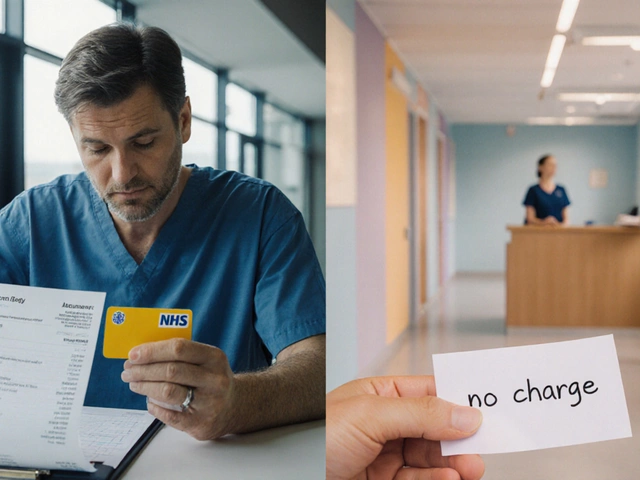When pain lingers past healing and steals your sleep, your focus, your social life-what do doctors actually prescribe that works? Here’s the no‑nonsense truth: there isn’t one magic pill. The right plan depends on the type of pain, your health risks, and what you want to do better. In the UK right now, guidelines lean on targeted medicines, short trials with clear goals, and non‑drug therapies that punch above their weight. I’ll walk you through the options, the rules of thumb doctors use, and how to get a plan you can live with.
TL;DR:
- First steps: activity‑based rehab, sleep support, and psychological therapies. Medicines are added to help you reach specific goals, not as a standalone fix.
- Neuropathic pain (burning, electric, pins & needles): duloxetine or amitriptyline are common first choices; gabapentin or pregabalin are alternatives.
- Joint or mechanical pain: topical NSAIDs (gels) first; short courses of oral NSAIDs if needed; paracetamol helps some but has modest effect.
- Topical options matter: lidocaine plasters for post‑shingles nerve pain; capsaicin cream or clinic‑grade patches for focal neuropathic pain.
- Opioids: not first‑line for long‑term non‑cancer pain. If used, it’s short‑term, low dose, with a stop plan. Many people do better without them.
- UK guidance touchstones: NICE (NG193 for chronic pain; CG173 for neuropathic pain), BNF dosing, Faculty of Pain Medicine opioid advice.
How doctors decide what to prescribe (and what they won’t)
Prescribing for chronic pain isn’t “pick a pill and hope.” It’s a structured process. In UK primary care, GPs start by nailing the pain type and ruling out red flags (fever, weight loss, trauma, progressive weakness, cancer history, rapidly worsening neurological signs). Then they match the pain pattern to the drug class most likely to help, set goals, and agree a review date. If you don’t hit the goal, they switch or stop.
Here’s the simple decision logic most clinicians use:
- Neuropathic pain (burning, shooting, electric shocks, allodynia): start with duloxetine or a low‑dose tricyclic (amitriptyline), or consider gabapentin/pregabalin. Adjust every 2-4 weeks.
- Nociceptive/mechanical pain (arthritic knees, tendon pain, low back strain): start with topical NSAIDs; add exercise therapy; consider short oral NSAID courses with stomach protection if risk factors.
- Chronic primary pain (e.g., fibromyalgia, IBS, chronic widespread pain, persistent low back pain without clear disease driver): focus on exercise, CBT/ACT, pacing, sleep changes. Consider duloxetine or amitriptyline if mood, sleep, or neuropathic features are present. NICE advises against opioids, benzodiazepines, antiepileptics, and long‑term NSAIDs for this group.
- Inflammatory pain (rheumatoid arthritis, axial spondyloarthritis): disease‑modifying therapy is key; NSAIDs as needed, co‑prescribed with gastro‑protection; rheumatology referral.
- Headache/migraine: triptans for attacks; beta‑blockers, topiramate, or CGRP monoclonal antibodies for prevention (specialist pathways).
Safety screens shape the plan: kidney disease (limits NSAIDs), liver disease (caution with paracetamol, duloxetine), mood disorders (watch antidepressant choices and doses), sleep apnoea or lung disease (be careful with pregabalin, opioids), pregnancy plans (avoid multiple classes). Doctors also check interactions using the BNF.
How to get the most from a GP appointment:
- Write a 1‑page pain snapshot: where it hurts, what it feels like, what makes it flare, what you can’t do that you want to do.
- Bring a 2‑week pain and activity diary (0-10 scores, sleep, meds taken, side effects).
- Arrive with one or two goals (example: “Walk 20 minutes daily within 6 weeks”).
- Expect a time‑limited drug trial (usually 4-8 weeks) alongside rehab. Agree what counts as success (often 30% less pain, better sleep, or more steps).
- Book the follow‑up to review effect and side effects. Stop or switch fast if it doesn’t help.
Guidance anchors:
- NICE NG193 (chronic pain, age 16+): prioritises non‑drug therapies, cautions against many meds in chronic primary pain, and supports shared decision‑making.
- NICE CG173 (neuropathic pain): duloxetine, amitriptyline, gabapentin, or pregabalin as first‑line options; topical lidocaine for post‑herpetic neuralgia.
- Faculty of Pain Medicine (opioids): use only if benefits outweigh harms, avoid dose escalation beyond low‑moderate ranges, and set an exit plan.
- CDC 2022 opioid guideline (contextual): similar principles-lowest effective dose, frequent review, avoid long‑term use in chronic non‑cancer pain.
Medicines commonly prescribed-and what they really do
Think of medicines as tools you pick for a specific job, then put back when they stop being useful. Here’s what UK clinicians actually prescribe, why, and the trade‑offs.
Paracetamol (acetaminophen)
- Role: modest help for some muscle or joint pain; safer stomach profile than NSAIDs.
- Limits: small average benefit for chronic low back pain and osteoarthritis in trials.
- Safety: don’t exceed 4 g/day; watch liver disease and alcohol.
- Typical: 1 g up to four times daily when needed; often used intermittently, not forever.
NSAIDs (ibuprofen, naproxen, diclofenac, celecoxib)
- Role: inflammation‑driven pain (arthritis flares, tendinopathy irritation), short courses.
- First choice form: topical gels for knees/hands reduce pain with fewer systemic risks.
- Oral use: short bursts at the lowest effective dose; add a PPI if you’re at GI‑bleed risk (age >45, history of ulcers, anticoagulants).
- Watch: stomach bleeds, kidney strain, blood pressure, cardiovascular risks. Avoid in advanced kidney disease.
- Typical: naproxen 250-500 mg twice daily; ibuprofen 200-400 mg three times daily.
Antidepressants for pain modulation (duloxetine, amitriptyline, nortriptyline)
- Role: neuropathic pain, chronic primary pain with sleep/mood issues, fibromyalgia.
- Why they help: they boost descending pain inhibition in the spine and brain.
- Duloxetine: start 30 mg daily; most settle on 60 mg. Nausea and sweating are common early; review at 4-6 weeks.
- Amitriptyline: start 10 mg at night; increase by 10 mg every 1-2 weeks (typical 10-30 mg). Watch dry mouth, morning grogginess.
- Notes: these are used at lower doses than for depression; they’re not “just for mood.”
Gabapentinoids (gabapentin, pregabalin)
- Role: nerve pain (post‑herpetic neuralgia, radiculopathy symptoms, diabetic neuropathy).
- Gabapentin: start 100-300 mg at night; titrate to 300 mg three times daily or higher if needed and tolerated.
- Pregabalin: start 75 mg twice daily; adjust based on response. Both are Schedule 3 controlled drugs in the UK, so expect monitoring.
- Watch: dizziness, sleepiness, weight gain, ankle swelling. Risk of misuse-taper rather than stop suddenly.
Topicals (lidocaine 5% plasters, capsaicin)
- Lidocaine 5%: licensed for post‑herpetic neuralgia; apply up to three plasters to painful skin for 12 hours on, 12 off.
- Capsaicin cream (0.025-0.075%): small, frequent applications for focal nerve pain; stings at first, then calms. High‑strength 8% patches are specialist‑only.
- Topical NSAIDs: first pass for osteoarthritis of knees/hands; fewer systemic side effects.
Opioids (codeine, tramadol, morphine, oxycodone, buprenorphine patches)
- Role: short‑term bridge during acute flares or cancer‑related pain. For long‑term non‑cancer pain, benefits often fade while risks grow.
- Rules of thumb (Faculty of Pain Medicine): try other options first; if used, keep doses low, review often, and reduce/stop if function doesn’t improve. Avoid escalating above moderate doses.
- Common issues: constipation, sleepiness, low testosterone, tolerance, dependence, falls, overdose risk-especially with sedatives, alcohol, or sleep apnoea.
- Typical short‑course doses: codeine 30-60 mg up to four times daily (max 240 mg/day); tramadol 50-100 mg up to four times daily (max 400 mg/day). Long‑acting forms only after careful review.
Muscle relaxants and benzodiazepines
- Chronic use isn’t recommended. Short, targeted use may help acute spasm, but for long‑term pain they add sedation without durable benefit.
Headache and migraine
- Acute: triptans (sumatriptan, rizatriptan) plus NSAID/paracetamol can be effective.
- Prevention: propranolol, topiramate, amitriptyline, or CGRP monoclonal antibodies (erenumab, fremanezumab) via specialist pathways if attacks are frequent.
Steroids and injections
- Oral steroids are rarely used for chronic pain and carry risks. Targeted injections (joint, bursa, epidural) can help specific problems; timing and diagnosis matter.
Medical cannabis
- NICE advises against cannabis‑based products for chronic pain outside clinical trials due to uncertain benefit and known risks (drowsiness, cognition, dependence). Some private clinics prescribe; NHS access is rare for chronic pain.
| Class | Examples | Best for | Common side effects | UK guidance stance | Typical starting dose |
|---|---|---|---|---|---|
| Paracetamol | Paracetamol | Mild joint/muscle pain | Liver risk at high doses | Modest effect; use cautiously | 1 g up to QID (max 4 g/day) |
| NSAIDs | Ibuprofen, Naproxen | Inflammatory/mechanical pain | GI upset/bleed, kidney strain | Topical first; oral short courses | Ibuprofen 200-400 mg TDS; Naproxen 250-500 mg BD |
| SNRI | Duloxetine | Neuropathic, fibromyalgia, OA pain | Nausea, sweating, insomnia | First‑line for neuropathic pain | 30 mg OD → 60 mg OD |
| TCA | Amitriptyline | Neuropathic pain, sleep issues | Dry mouth, sedation | First‑line option (off‑label dose) | 10 mg nocte, titrate by 10 mg |
| Gabapentinoids | Gabapentin, Pregabalin | Neuropathic pain | Dizziness, drowsiness, oedema | First‑line/alternative; controlled | Gabapentin 100-300 mg → TDS; Pregabalin 75 mg BD |
| Topical anaesthetic | Lidocaine 5% plaster | Post‑herpetic neuralgia | Skin irritation | Recommended for focal neuropathic pain | Up to 3 plasters, 12 h on/12 h off |
| Topical capsaicin | 0.025-0.075% cream; 8% patch | Focal neuropathic pain | Burning/sting on application | Cream OTC; 8% patch specialist | Apply small amounts TID-QID |
| Opioids | Codeine, Tramadol, Morphine | Short‑term flares, cancer pain | Constipation, sedation, dependence | Not for chronic primary pain; short trials only | Codeine 30-60 mg Q4-6h; Tramadol 50-100 mg Q6h |
Quick rule: any medicine should earn its place by helping you do more of what you value. If it doesn’t, it’s a passenger-time to get it off the bus.

Non‑drug prescriptions that move the needle
Meds help, but the heavy lifters in chronic pain are often not in a pill bottle. UK guidance calls these first‑line for a reason.
Exercise therapy
- Graded, regular movement reduces pain sensitivity and improves mood. Start low, go slow, and make it automatic (think daily 10‑minute walks, then build).
- Physiotherapy helps pick the right mix: strength, mobility, pacing. If a move flares pain by 1-2 points but settles by the next day, you’re in the sweet spot.
Psychological therapies (CBT, ACT)
- These don’t say “it’s in your head.” They retrain how your nervous system responds and help you pace activity. NICE backs them for chronic primary pain.
- Online courses or group programmes through NHS pain services can be as effective as 1:1 for many people.
Sleep and stress care
- Poor sleep fuels pain. A basic plan: fixed wake time, daylight within 30 minutes, caffeine curfew after lunch, wind‑down hour, cool/dark room.
- If insomnia persists, ask about CBT‑I (cognitive behavioural therapy for insomnia). It often beats pills.
Acupuncture
- NICE allows considering acupuncture for chronic primary pain after discussion of benefits and costs. If you try it, give it at least 6-8 sessions before judging.
Weight, nutrition, pacing
- Even 5-10% weight loss can ease joint load and systemic inflammation. Protein with each meal helps with recovery and satiety.
- Pacing means breaking tasks into chunks, resting before you crash, and building in micro‑recovery.
Interventional options
- Targeted injections (facet joints, SI joints, bursae), radiofrequency ablation for some back/neck pain, and nerve blocks can help the right person at the right time. Referral to a pain clinic is the path.
- TENS (a small device that sends gentle electrical pulses) helps some people and is safe to try.
How to put it all together with your GP:
- Pick 1-2 medicines that match your pain type.
- Add one movement goal and one sleep change you can actually keep.
- Set a 6-8 week review. Keep a diary: pain, function (steps, minutes of activity), sleep, side effects.
- If no meaningful gain, switch class or step down. If you gain, consider a gentle dose reduction after 8-12 weeks to find the minimal helpful dose.
Cheat‑sheet: safe use checklist
- One change at a time. That way you know what’s doing what.
- Use a PPI if you’re on regular oral NSAIDs and have GI risk factors.
- Don’t mix sedatives: pregabalin/gabapentin + opioids + alcohol = risky.
- Taper many meds to stop (TCAs, SNRIs, gabapentinoids, opioids). Your GP will map the taper.
- Set calendar reminders for reviews; chronic repeats without review creep up quietly.
Mini‑FAQ, quick answers, and next steps
Common follow‑ups I hear in clinic, answered straight.
Will my GP prescribe opioids for chronic back or joint pain? Usually not long‑term. NICE and the Faculty of Pain Medicine advise against ongoing opioids for chronic primary pain. Short courses might be used for an acute flare while other treatments kick in, with a clear stop date.
Are gabapentin and pregabalin addictive? They carry misuse and dependence risks, which is why they’re controlled drugs in the UK. Used with a plan and regular reviews, many people tolerate them well. Never stop abruptly-taper with your GP.
Can I get medical cannabis on the NHS for chronic pain? It’s rare. NICE does not recommend it for chronic pain outside trials. Some private clinics prescribe; weigh cost, driving restrictions, side effects, and uncertain benefit.
How long until pain meds work? Neuropathic options (duloxetine, amitriptyline) need 2-6 weeks at a steady dose. Gabapentin/pregabalin titration can take a few weeks. NSAIDs work within days. Give each trial enough time unless side effects are a show‑stopper.
Can I drive? UK DVLA expects you not to drive if medicines make you unsafe (sleepy, dizzy). Some drugs carry specific cautions (opioids, pregabalin). If in doubt, don’t drive and talk to your GP/pharmacist.
What if I’m pregnant or trying? Plans change. Avoid certain meds (e.g., many anticonvulsants, some antidepressants). Speak to your GP early for safer options.
Can I combine meds? Often yes, but smartly: topical + oral NSAID usually isn’t necessary; TCA or SNRI can be combined with gabapentin/pregabalin in careful steps; avoid layering sedatives. Always check interactions with your pharmacist.
What blood tests or scans do I need? Only if your history/exam suggests something specific. Chronic pain rarely needs repeated imaging. Your GP may check kidney/liver function before certain meds or if you’re on them long‑term.
What counts as success? A 30% drop in pain, better sleep, or more steps per day-plus fewer bad days-are meaningful wins. Function matters more than a zero on the pain scale.
Next steps for common scenarios:
- Burning, electric pain down a leg/arm: ask about duloxetine vs amitriptyline first, with a physio plan. If not enough by 4-6 weeks, consider switching class or adding gabapentin/pregabalin.
- Knee/hand osteoarthritis: try topical NSAID gel daily for 2-4 weeks, add strengthening exercises, consider weight‑loss support. Short oral NSAID course for flares, with a PPI if at risk.
- Fibromyalgia/chronic widespread pain: anchor on graded exercise, pacing, CBT/ACT. Consider low‑dose amitriptyline at night or duloxetine if mood/sleep are issues. Avoid long‑term opioids and benzodiazepines.
- Post‑shingles nerve pain: lidocaine 5% plasters, plus duloxetine or amitriptyline; consider gabapentin/pregabalin if needed. Give each step time.
- Persistent post‑surgical pain (3+ months): treat as neuropathic; similar options as above; involve the surgical team or pain clinic if severe.
- Cancer‑related pain: opioids have a bigger role. Ask for a specialist review for balanced relief and side‑effect control.
One last thing: meds are helpers, not heroes. Build your base-movement, sleep, pacing-and let the right pill support that plan. If your repeat prescriptions have grown messy, it’s not your fault. Book a review, bring your goals, and ask, “Which two of these still earn their keep?”
Pro tip: your pharmacist is a goldmine. Ask them to check for interactions, timing tweaks (e.g., night‑time dosing for groggy meds), and taper schedules. Many run NHS medication review services you can book directly.
If you’re after a single phrase to remember, make it this: choose the right tool, test it properly, and don’t be afraid to stop what doesn’t help. That’s how you win with chronic pain medications in 2025.





